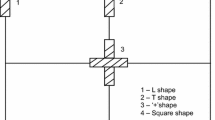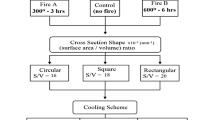Abstract
Fire resistance of reinforced concrete (RC) columns in design codes is based on concentric loading conditions. The effect of eccentric loads on spalling and fire resistance of RC columns is a matter of investigation. The present study, therefore, broadly aims to determine the influence of relative levels of spalling under eccentric loads on fire resistance of RC columns. Experimental investigation is done on 3.15 m long column specimens. The experimental results indicate that the increase in load eccentricity (from 20 mm to 40 mm) increases the amount of spalling leading to exponential decrease in fire resistance (by 43%). Spalling is restricted by increase in longitudinal bars, particularly mid-perimeter bars, contributing to increase in fire resistance by 100% with doubling of number of longitudinal bars. Even the decrease in spacing of transverse reinforcement (from 300 mm to 150 mm) for eccentric loads leads to 123% increase in fire resistance. However, this advantage is limited by greater amount of compression face spalling (400% more) under eccentric loads, which is seen to increase with the density of reinforcement. For explosively spalled high strength columns, further reduction in fire resistance occurs on account of local softening of longitudinal reinforcement due to early (10 min) and protracted (up to 58 min) deep spalling. The chances of global column element buckling become more dominant with increase in load eccentricity around 40 mm. It is concluded that spalling levels change with relative change in reinforcement detailing with other parameters under eccentric loads. From this study, it is concluded that the feasibility of existing methods of determination of fire resistance for eccentrically loaded columns are inadequate and need to be revised to as per the results of this study.



















Similar content being viewed by others
Abbreviations
- RC:
-
Reinforced concrete
- HSC:
-
High strength concrete
- NSC:
-
Normal strength concrete
- Phi(l):
-
Dia of longitudinal reinforcement
- RH:
-
Relative humidity
- e(x):
-
Uni-axial eccentricity
- P(u):
-
Ultimate design load
- P :
-
Axial load
- Leff :
-
Effective length of column
- deff :
-
Effective depth of column
- U(max):
-
Maximum lateral deflection
- Sa :
-
Spalling amount
- Sd :
-
Spalling damage factor
- Dc :
-
Damage amount compression
- Dt :
-
Damage amount tension
- L(sc):
-
Spalling length compression
- L(st):
-
Spalling length tension
- W(sc):
-
Spalling width compression
- W(st):
-
Spalling width tension
- D(sc):
-
Spalling depth compression
- D(st):
-
Spalling depth tension
- L(c/t):
-
Length-compression/tension
- W(c/t):
-
Width-compression/tension
- d(c/t):
-
Depth-compression/tension
- t((f):
-
Fire resistance (min)
- T(g):
-
Thermal gradient
- Sw :
-
Spacing of transverse Rf
- Leff :
-
Effective length
- deff :
-
Effective depth
- Ast :
-
Area of steel reinforcement
- fy :
-
Yield strength of steel
- D:
-
Column section depth
- n :
-
Number of longitudinal bars
- fc :
-
Concrete cube Strength
References
ACI 216 (2010) Code requirements for determining fire resistance of concrete and masonry. Tech rep, American Standards, MI
ACI 318 (2008) Building code requirements for structural concrete (ACI 318-08 ). Tech rep
Ali F, Nadjai A, Silcock G, Abu-Tair A (2004) Outcomes of a major research on fire resistance of concrete columns. Fire Saf J 39(6):433–445, https://doi.org/10.1016/j.firesaf.2004.02.004
Ali F, Nadjai A, Choi S (2010) Numerical and experimental investigation of the behavior of high strength concrete columns in fire. Eng Struct 32(5):1236–1243
AS 3600 (2009) Australian standard-concrete structures. Tech rep, Standards Australian Committee, Sydney
Buch SH, Sharma UK (2017) Fire resistance of reinforced concrete columns—a systematic review. In: Gillie M, Wang Y (eds) Applications of fire engineering: proceedings of the international conference of applications of structural fire engineering (ASFE 2017), September 7–8, 2017. Manchester, UK
Dotreppe JC, Franssen JM, Bruls A, Baus R, Vandevelde P, Minne R, van Nieuwenburg D, Lambotte H (1997a) Experimental research on the determination of the main parameters affecting the behaviour of reinforced concrete columns under fire conditions. Mag Concr Res 49(179):117–127, https://doi.org/10.1680/macr.1997.49.179.117
Dotreppe JC, Franssen JM, Bruls A, Baus R, Vandevelde P, Minne R, van Nieuwenburg D, Lambotte H (1997) Experimental research on the determination of the main parameters affecting the behaviour of reinforced concrete columns under fire conditions. Mag Concr Res 49(179):117–127
Dwaikat M, Kodur V (2009) Hydrothermal model for predicting fire-induced spalling in concrete structural systems. Fire Saf J 44:425–434
EN 1992-1-2 (2004) Design of concrete structures-part 1–2: general rules—structural fire design. Tech Rep 2004, CEN, Brussels
EN-1998-1 (2004) Eurocode 8: design of structures for earthquake resistance. Tech rep, CEN, Brussels
EN1992-1-1 (2004) Design of concrete structures—part 1–1: General rules and rules for buildings. Tech Rep 2004, CEN, Brussels
Hass R (1986) Practical rules for the design of reinforced concrete and composite columns submitted to fire. Tech rep 69
Heo Ys, Han CG, Kim Km (2015) Combined fiber technique for spalling protection of concrete column, slab and beam in fire. Mater Struct 48:3377–3390
Hertz K (2003) Limits of spalling of fire exposed concrete. Fire Saf J 38(2):103–116
IS-13920 (1993) Ductile detailing of reinforced concrete structures subjected to seismic forces-code of practice. Tech rep, Bureau of Indian Standards (BIS), New Delhi
IS-1642 (1989) Fire safety of buildings (general): details of construction-code of practice. Tech rep, Bureau of Indian Standards (BIS), New Delhi
IS-456 (2000) Plain and reinforced concrete-code of practice. Tech rep, Bureau of Indian Standards (BIS), New Delhi
Kodur V, Mcgrath R (2003) Fire endurance of high strength concrete columns. Fire Technol 39(1):73–87
Kodur V, Raut N (2011) Response of reinforced concrete columns under fire-induced biaxial bending. Struct J 108(5):610–619
Kodur V, Raut N (2012) A simplified approach for predicting fire resistance of reinforced concrete columns under biaxial bending. Eng Struct 41:428–443
Kodur V, McGrath R, Leroux P, Latour JC (2005) Experimental studies for evaluating the fire endurance of high-strength concrete columns. Tech rep research report no. 197, National Research Council (NRC), Canada
Lie T (1989) Fire resistance of reinforced concrete columns—a parametric study. J Fire Prot Eng 1(4):121–129
Seręga S (2015) Effect of transverse reinforcement spacing on fire resistance of high strength concrete columns. Fire Saf J 71:150–161
Shah AH, Sharma U (2017) Fire resistance and spalling performance of confined concrete columns. Constr Build Mater 156:161 – 174
Author information
Authors and Affiliations
Corresponding author
Rights and permissions
About this article
Cite this article
Buch, S.H., Sharma, U.K. Fire Resistance of Eccentrically Loaded Reinforced Concrete Columns. Fire Technol 55, 1517–1552 (2019). https://doi.org/10.1007/s10694-019-00823-x
Received:
Accepted:
Published:
Issue Date:
DOI: https://doi.org/10.1007/s10694-019-00823-x




